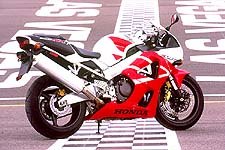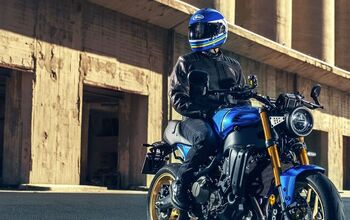First Ride: 2000 Honda CBR929RR - Motorcycle.com
LOS ANGELES, January 31, 2000 -- In 1998 Yamaha's YZF-R1 roared onto the scene, and in one fell swoop everyone seemed to forget that the Honda CBR900RR existed. This was an unusual position for Honda. After all, the 900RR practically created the liter-class sportbike niche. To add insult to injury, the R1 wasn't the only motorcycle to challenge the RR's dominance.
Kawasaki's 1998 ZX-9R boasted a motor that, quite simply, left the 900RR breathing exhaust fumes. Honda is not used to seeing their machines as also-rans, but in today's ultra-competitive sportbike market, a return to the top doesn't take place with a twitch of the nose or a blink of the eyes.
Latest and Greatest from Honda: The CBR929RR. (At least until we ride the RC51.) It has taken two years for Honda to fire back (that's about a decade in sportbike years), and they're pretty confident about the fruits of their labor. Underscoring the high stakes and increased competition, Honda's marketing department shifted into sixth gear and before anyone in the two-wheeled press swung a leather-clad leg over the seat of the all-new CBR929RR, Honda was hailing it as the "lightest, best-handling and most responsive open-class production sportbike in the world."
The new-from-the-ground-up CBR929RR is the bike that Honda hopes will carry them to the "pole position" in much the same way the original 900 did back in '92. As such, Honda claims the new 929 "exposes ordinary sportbikes for what they have just become. Ordinary." Sounds like Honda's talkin' the talk but can they walk the walk? That's why we were here at Las Vegas Motor Speedway: To find out whether or not the CBR929RR's has enough go to match show.
The new 929 incorporates a number of features that, for its $9,999 price tag, make it a remarkable motorcycle. The bike bristles with advanced bits and pieces everywhere that make this motorcycle a force to be reckoned with, even while parked on the side stand. For example, there are not only bits but literally blocks of titanium and magnesium used to help Honda achieve their goal of making the new CBR the "must-have motorcycle of the new millennium."
"The new 929 incorporates a number of features that, for its $9,999 price tag, make it a remarkable motorcycle."
Just about every engine internal, from camshafts to the crankshafts, lost weight in an effort to prove that indeed, "Light Does Make Right." So what makes the 929 a "must-have?" First, we should ask a question that must be on the minds of many prospective buyers: Why not bore the 929 into a full 1000cc so it's not starting off with a displacement disadvantage? Honda felt the added displacement would make the motor taller and heavier, thereby upsetting the bike's balance, handling and performance, factors that are every bit as important as a impressive dyno chart graph.
According to the Honda mantra, smaller means lighter and, as Large Project Leader Tadao Baba said, "It means that light weight is the right way." Light weight was clearly Honda's number one design priority.
When Honda first introduced their CBR900RR in the spring of 1992, it set new standards for open-class sportbikes. At a claimed 408 pounds dry, not only was the bike 80 pounds lighter than its closest competitor, it was two pounds lighter than the CBR600F2. Honda has pushed the "Light Makes Right" philosophy throughout the CBR900 series' existence with numerous weight-saving, suspension improvements and an increase in displacement that saw the 1999 900RR measuring in at 918cc and about 400 pounds dry.
For much of the 1990s, Honda's CBR900RR, along with the Suzuki GSX-R750, was the large-displacement sportbike of choice. Honda claims the new 929cc engine (last year's displacement was 918cc) produces more than 150 hp at 11,500 rpm (22% more ponies), 76 ft-lbs. of torque (up 17%) and weighs in at 379 pounds dry (the 900RR weighed 397). This not only gives the CBR929 a higher horsepower-per-liter rating than any other bike in its class -- approximately 160 hp/1000cc -- but it also weighs less than the Yamaha R1's 385 pound claimed dry weight.
The new motor is fed fuel and oxygen via 40mm throttle-bodies that, with injectors spraying fuel at a rate of 50 psi, should combine with the electronic digital ignition in an effort to provide immediate throttle response in any gear. The injection system features an auto-enrichening circuit that eliminates the need for a manual choke. Part of this induction tract includes a gargantuan ten-liter airbox (last year's was 7.4 liters) and a narrow, 25-degree included valve angle (13-degree intake, 12-degree exhaust) that provides a direct path for the air/fuel mixture into the aluminum composite cylinder sleeves.
The motor is now more over-square with a 74 x 54mm bore and stroke. Combined with an 11.3:1 compression ratio, the new engine is able to rev a safe 500 rpm higher. The new crankshaft is 12% lighter and the new pistons, also weighing 12% less, are now forged instead of cast. Even the camshafts lost weight -- a significant 1.4 pounds for both. Reducing rotating and reciprocating mass provided the added revs and also made the engine faster spinning through the powerband, thus improving the throttle response.
In addition to the Variable Intake/Exhaust Management System (HVIX) -- a flapper valve in the airbox that maintains a constant velocity, variable-volume flow of air to the FI system -- the CBR929RR also features the debut of Honda's HTEV, or Honda Titanium Exhaust Valve, which is similar in theory to the EXUP system found on Yamaha's R1. At engine speeds of less than 7,500 rpm, a specially designed exhaust valve acts as a 360-degree exhaust collector to help boost low- and mid-range power.
In the upper levels of the powerband it turns into a 180-degree collector in an effort to achieve maximum power output while retaining a high-degree of efficiency and rideability. The unit is machined out of titanium and is, all by itself, a beautiful work of craftsmanship.
Sticky, Stiff Stuff Or: 16.5-inch Wheels R.I.P. Just because Honda mentions phrases like "engine also acts as a stressed member of the chassis," "pivotless frame" and "tuned-flex design" in the same breath, don't fret about upsetting the chassis by fitting sticky race-tires on the new 929. (Remember Honda's warnings about the VTR chassis?). This motorcycle was made for sticky tires, hence Michelin's awesome Pilot Sport radials wrapping around new 17-inch rims (Hurrah!) as stock equipment.
The all-new engine also acts as a stressed member of the chassis, and the all-new, twin-spar aluminum frame features a pivotless frame design that Honda has used on the VTR1000 Super Hawk and the VFR800 Interceptor. The frame itself is totally a new, twin-spar, triple-box-section extruded aluminum unit welded to large castings at the steering head and rear suspension mounting point.
The swingarm mounts directly to the back of the engine cases. The powerful 929 engine created the need for a massive cast aluminum bracket below and between the swingarm pivots in order to increase chassis rigidity. All this is supposed to offer an "exceptionally light, tuned-flex design," that offers excellent rider feedback.
Even though the new frame weighs 2.3-pounds less, with the engine bolted in place it is now 13% stiffer. And, because of the motor's shorter crankcases (front to rear), the motor is now situated farther forward in the frame to place more weight on the front wheel. This allowed engineers to utilize knowledge garnered from 500 GP racing and run a 21mm longer swingarm to improve suspension action.
The whole package is suspended by fully-adjustable Showa units both front and rear. The rear mono-shock utilizes Honda's Pro Link® linkage with a revised ratio, and the shock body now features a piggy-back reservoir that weighs 12.5-ounces less than previous remote-reservoir unit. Inverted telescopic front forks are a first for an open-class Honda street bike. The rear shock supplies 135mm of up and down wheel travel and mates with the 110mm of travel provided by the new forks.
Inverted front forks -- the first on a Honda open-class sportbike. The new 43mm Showas weight 2.6 pounds less than the 900RR's. Even better, a 17-inch wheel is found in between. Woo-Hoo!
With so many performance-oriented changes, don't think Honda left the 929 looking plain-wrapped, either. The all-new bodywork features a three-headlight, side-by-side design, a narrow-profile fuel tank (still retaining a 4.8 gallon capacity) and a one-piece tail section wrapped around a removable rear subframe.
More by MO Staff

































Comments
Join the conversation